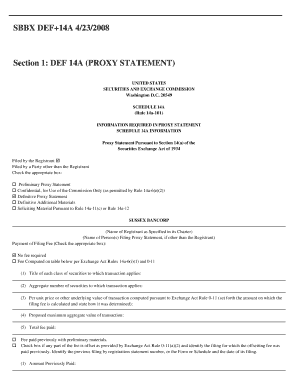Decoding The Proxy Statement (Form DEF 14A): A Step-by-Step Analysis

Table of Contents
Understanding the Purpose of a Proxy Statement (Form DEF 14A)
The DEF 14A, also known as a proxy statement, is a crucial document sent to shareholders before a shareholder meeting. Its primary purpose is to inform shareholders about matters to be voted on, allowing them to make informed decisions regarding their investments. These matters often include electing directors to the board, approving mergers and acquisitions, ratifying the appointment of auditors, and other significant corporate actions. The information provided in the proxy statement is essential for informed shareholder voting and effective participation in corporate governance.
- Provides details on proposed executive compensation: This includes salaries, bonuses, stock options, and other benefits, allowing shareholders to assess the fairness and reasonableness of executive pay packages.
- Outlines major corporate decisions requiring shareholder approval: Shareholders need to understand the implications of these decisions before casting their votes. This section is critical for understanding the company’s strategic direction.
- Gives insight into company performance and future plans: While not the primary focus, the proxy statement often provides context regarding the company's financial health and future plans which can inform voting decisions.
- Enables shareholders to exercise their voting rights effectively: The DEF 14A empowers shareholders by providing the necessary information to make informed choices during the shareholder voting process.
Key Sections of a Proxy Statement (Form DEF 14A) to Analyze
The proxy statement (Form DEF 14A) contains several key sections requiring careful review. Understanding these sections allows investors to assess the company’s governance, performance, and future prospects.
Executive Compensation
This section details the compensation packages of executive officers. Analyzing this section is vital to identify potential conflicts of interest or excessive pay.
- Analyze CEO and other executive compensation packages: Compare the compensation to the company’s performance and industry benchmarks. Look for trends and significant changes year-over-year.
- Identify potential excessive compensation packages and red flags: Scrutinize unusually high compensation relative to performance, or packages heavily weighted towards short-term gains.
- Compare compensation to industry peers and company performance: This comparative analysis provides valuable context and helps identify potential discrepancies.
Board of Directors
Understanding the board's composition, qualifications, and independence is paramount. A strong, independent board is crucial for good corporate governance.
- Review director biographies and backgrounds: Assess the expertise and experience of each board member.
- Assess board diversity and independence: A diverse and independent board is better equipped to provide oversight and challenge management decisions. Look for potential conflicts of interest.
- Identify potential conflicts of interest among board members: This might involve existing relationships with management or significant holdings in other companies.
Shareholder Proposals
This section presents proposals submitted by shareholders for consideration at the meeting. These proposals can cover a wide range of issues, from environmental and social concerns to corporate governance improvements.
- Evaluate the merits of each shareholder proposal: Weigh the potential impacts of the proposed changes.
- Understand the management's recommendation on each proposal: Consider management's rationale and compare it to your own assessment.
- Determine your voting stance based on the information provided: Use the information in the proxy statement to inform your voting decisions on each proposal.
Mergers and Acquisitions
If a merger or acquisition is proposed, this section will detail the terms and rationale. Understanding this information is critical for assessing the potential impact on the company and its shareholders.
- Analyze the financial terms of the proposed transaction: Examine the valuation, the method of payment, and any contingent payments.
- Evaluate the strategic rationale behind the merger or acquisition: Consider the potential synergies, cost savings, and market expansion opportunities.
- Assess potential risks and benefits of the proposed transaction: Identify potential integration challenges, debt burdens, and dilution of shareholder value.
Decoding the SEC Filings: Using the DEF 14A Effectively
The Securities and Exchange Commission (SEC) oversees the accuracy and completeness of proxy statements (Form DEF 14A). The SEC ensures companies provide shareholders with accurate and timely information.
- Access DEF 14A filings directly through the SEC's EDGAR database: EDGAR (Electronic Data Gathering, Analysis, and Retrieval system) is a free online database containing SEC filings.
- Use online tools to analyze and compare DEF 14A filings across different companies: Several online resources can facilitate comparison and analysis of these filings.
- Utilize the information to make informed investment and voting decisions: The information within the DEF 14A is a powerful tool for responsible and impactful investing.
Conclusion
Successfully navigating the complexities of a proxy statement (Form DEF 14A) is key to responsible and informed investing. By systematically analyzing the key sections outlined above – executive compensation, board composition, shareholder proposals, and potential mergers – investors can effectively participate in corporate governance and make sound investment decisions. Don't just passively receive your proxy statement; actively decode it to maximize your returns and exercise your shareholder rights. Learn to master the Proxy Statement (Form DEF 14A) and take control of your investments today!

Featured Posts
-
 Analyzing The Impact Of Sexual Misconduct And Multiple Affair Accusations On Donald Trumps Political Career
May 17, 2025
Analyzing The Impact Of Sexual Misconduct And Multiple Affair Accusations On Donald Trumps Political Career
May 17, 2025 -
 Nba Prediction Knicks Vs Pistons A Detailed Analysis
May 17, 2025
Nba Prediction Knicks Vs Pistons A Detailed Analysis
May 17, 2025 -
 Valerio Therapeutics 2024 Financial Statement Approval Delayed
May 17, 2025
Valerio Therapeutics 2024 Financial Statement Approval Delayed
May 17, 2025 -
 Reddit Service Restored Following Recent Outage Users Can Access Platform Again
May 17, 2025
Reddit Service Restored Following Recent Outage Users Can Access Platform Again
May 17, 2025 -
 350 Te Burgosur Shkembyer Si Emiratet E Bashkuara Arabe Lehtesuan Marreveshjen Midis Rusise Dhe Ukraines
May 17, 2025
350 Te Burgosur Shkembyer Si Emiratet E Bashkuara Arabe Lehtesuan Marreveshjen Midis Rusise Dhe Ukraines
May 17, 2025
